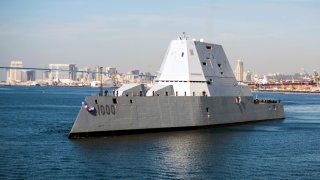Need for Speed: Zumwalt Destroyers to Fire Hypersonic Missiles
Though they lacked a clear mission set, the stealthy ships could become a significant strategic asset.
The U.S. Navy’s troubled Zumwalt-class of guided missile destroyers could each end up with twelve hypersonic missiles in the coming years.
Speaking at the annual Naval Submarine League, Vice Adm. Johnny Wolfe, head of the Navy’s strategic systems programs, told reporters that the Zumwalts hulls have enough onboard space to accommodate multiple missile tubes that would ultimately house hypersonic weapons.
“We’re talking about deploying this system on DDG-1000 in 2025, that’s three years from now,” Vice Admiral Wolfe said.
“We got to get on with getting all of the design for the Zumwalt, getting all of those tubes in there, as we pulled out the forward gun mounts. We’ve gotten to put these large diameter tubes in there, and then finish the integration work into the combat system.”
The Navy originally intended the stealthy Zumwalt class to support troops on shore with a pair of naval guns—essentially advanced, long-range 155mm artillery pieces. However, that plan never came to fruition, as the ammunition for the naval guns was prohibitively expensive.
The hypersonic missile in development for the Zumwalts will be fielded in two variants: one for the Navy and one for the Army, a development and acquisition strategy that will reduce program costs for both branches.
“You need to have the same lethality no matter where you’re at. And that’s what this weapon does,” Vice Admiral Wolfe said. “It’s all the same with the lethality to get after all these targets. It just depends on who’s launching it, right, whether it’s the Army … or whether it’s a Zumwalt, or whether it’s a Virginia-class submarine.”
Integrating hypersonic weapons into the Zumwalts will also give them a clear mission—a significant development for a platform whose purpose has been unclear.
“On these high-end systems, it is no longer affordable for a single service to do that. We’re working with the [Office of the Secretary of Defense], we’re working with the Army and with what our resource sponsor is doing to figure out how we build this capability once and get out to multiple platforms,” Wolfe explained.
“It’s strategic, but it’s not nuclear. If you look at the numbers, particularly with what we’re going to with the ranges, it is very much a strategic asset. You can hold very high-value targets at risk … and you can do that with all these various platforms,” Vice Admiral Wolfe explained to USNI News.
Though not yet in service, hypersonic-armed Zumwalts—combined with their stealthy hull design—could prove to be useful.
Caleb Larson is a multimedia journalist and defense writer with the National Interest. A graduate of UCLA, he also holds a Master of Public Policy and lives in Berlin. He covers the intersection of conflict, security, and technology, focusing on American foreign policy, European security, and German society for both print and radio. Follow him on Twitter @calebmlarson.
Image: Flickr/U.S. Navy.

